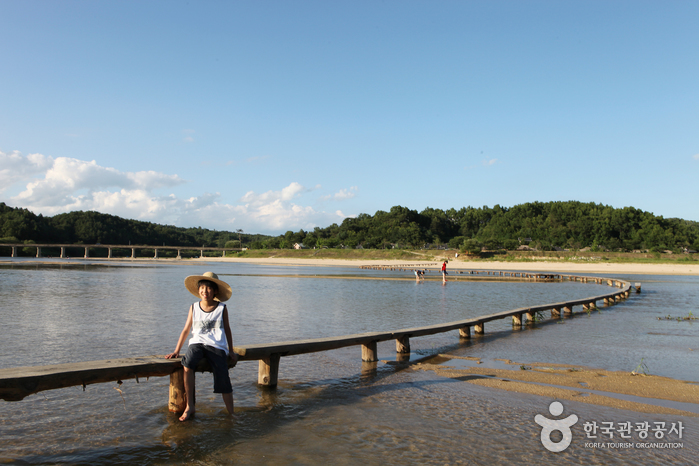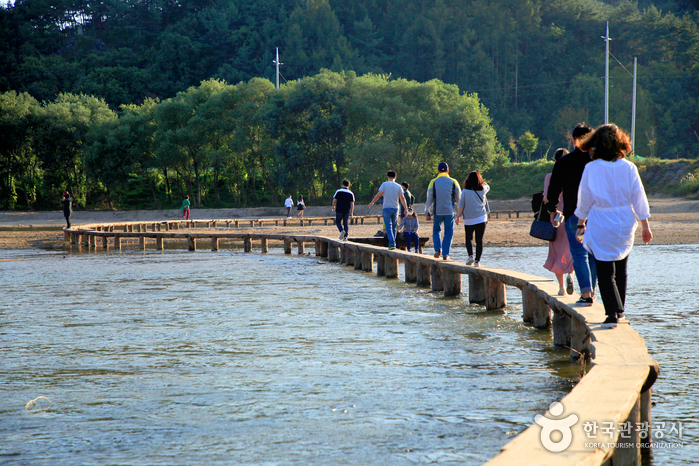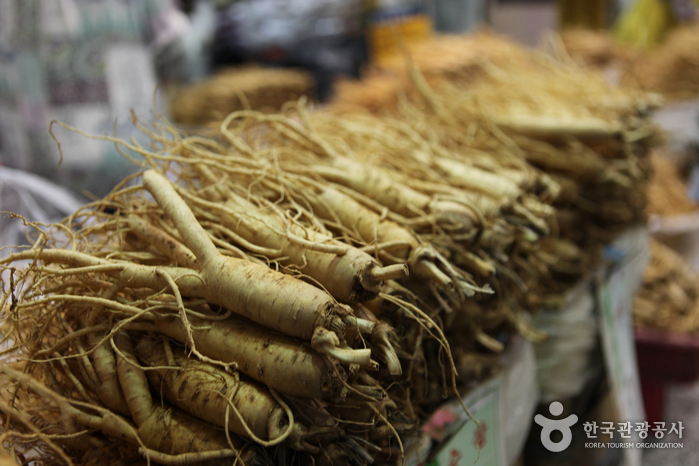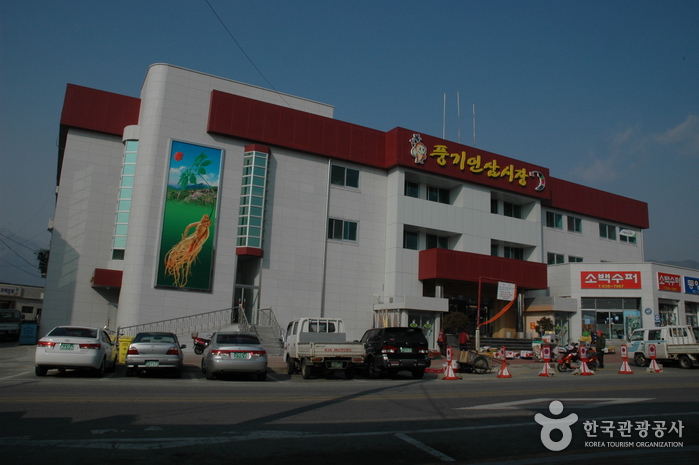Homeplus - Yeongju Branch [Tax Refund Shop] (홈플러스 영주)
0m 0 2024-04-18
29, Daehak-ro, Yeongju-si, Gyeongsangbuk-do
-
Olive Young - Gyeongbuk Yeongju Station Branch [Tax Refund Shop] (올리브영 경북영주역점)
71.93511172168083m 0 2024-06-27
35, Daehak-ro, Yeongju-si, Gyeongsangbuk-do
-
Yeongju Modern History & Culture Street (영주근대역사문화거리)
2.1 Km 0 2024-02-23
Yeongju-dong, Yeongju-si, Gyeongsangbuk-do
Yeongju Modern History and Culture Street serves as a historical and cultural hub, encapsulating the life and times of early twentieth-century Yeongju. The street is dotted with cultural properties officially recognized by the Cultural Heritage Administration. Highlights include the preserved official residences No. 5 and No. 7 of Yeongju Station, once home to railway station employees. Additionally, visitors can explore the Pungguk Rice Mill, showcasing vintage rice milling machinery; Yeongju Jeil Church, a 1909-built structure exemplifying Gothic-style architecture; Yeongju-dong Modern Hanok, a subsidiary structure of an ancient residence; and the still-operating Yeonggwang Barber Shop, a testament to the area's enduring heritage.
Seoneulgi Culture [Korea Quality] 서늘기문화[한국관광 품질인증]
4.6 Km 0 2023-12-04
119-1, Changjin-ro 194beon-gil, Yeongju-si, Gyeongsangbuk-do
+82-10-4891-7622
Seoneulgi Culture hanok stay in Yeongju, Gyeongsangbuk-do looks like one traditional hanok from the front, but in truth, is three houses. The guestrooms are a sarangchae with two rooms, ondol flooring, a private bathroom, veranda and front yard, and a middle building with a sleeping room, ondol attic, traditional kitchen, private bathroom and back yard. Barbecue equipment can be rented, and tents are available year-round. Downtown Yeongju is 5 minutes away by car.
Museom Single-Log Bridge Festival (무섬외나무다리축제)
8.6 Km 4862 2021-01-09
41, Museom-ro 234beon-gil, Yeongju-si, Gyeongsangbuk-do
• 1330 Travel Hotline: +82-2-1330 (Korean, English, Japanese, Chinese) • For more info: +82-54-630-8703
Museom Village is surrounded by water on three sides as it is located at the place where Naeseongcheon Stream (the upstream of Nakdonggang River) and Seocheon Stream meet. The village is called Sudori, or Museom, meaning an island in an inland area. It is a traditional village which has nine cultural assets, including Haeudang House (Folk Item No. 92).
The Museom Single-Log Bridge Festival, a landmark celebration of Yeongju, is held every October. The Museom Single-Log Bridge is one of the 100 most beautiful paths of Korea selected by the Ministry of Land, Transport and Maritime Affairs. The bridge is only 23-centimeters wide and it connects the village to the land across the stream surrounding it. The festival aims to preserve and promote the nation’s traditional culture. During the festival, one can enjoy and take part in a wide variety of folk events including the intramural Ssireum (traditional wrestling) Competition, Nongak (farmer’s music) Performance, Satto (chief of the village) Parade, crossing the bridge with a cow, a groom marching on a horse and a traditional wedding ceremony.
Manjukjae House[Korea Quality] / 만죽재 고택[한국관광 품질인증]
8.6 Km 1 2023-10-24
11-10 , Museom-ro 234beon-gil, Yeongju-si, Gyeongsangbuk-do
+82-54-638-1127
Manjukjae House is the oldest hanok in Museom Village, Yeongju, Gyeongsangbuk-do, with a history dating back 360 years. Originally built by Park Su to live the life of a reclusive gentleman after the Manchu Invasion of Korea, the house has been passed down from generation to generation through 13 generations. There are four guest rooms, Seomgye Chodang, Sarangchae (detached building), Anchae (main building), and Chaekbang (study), all of which can accommodate two people. Among them, Seomgye Chodang offers the best view, from where guests can enjoy the scenery of the log bridge in Museom Village, the Naeseongcheon Stream, and the white sandy beach. With the windows wide open, you can enjoy the cool breeze and the soothing sounds of nature.
Yeongju Museom Village (영주 무섬마을)
8.7 Km 21936 2021-08-24
31-12, Museom-ro 234beon-gil, Yeongju-si, Gyeongsangbuk-do
+82-54-638-1127
Located in Sudo-ri in Yeongju, Gyeongsangbuk-do, Museom Village is a charming hanok village surrounded by water. Flowing down from Sobaeksan Mountain and Taebaeksan Mountain, Naeseongcheon Stream and Yeongjucheon Stream converge and loop around Museom Village, surrounding the village on three sides with water. This peninsula-like village is not only the center of traditional Korean culture, but also has a gorgeous natural landscape complete with a wide sandy riverside and a lush inland forest.
Known for Haeudang and Manjukje Houses (two of the most historical hanok houses in the area), the village is also home to other outstanding traditional houses such as the Kim Gyu-jin House and the Kim Wi-jin House. Manjukje House is located at the heart of the village and the oldest traditional house in this hanok village. Manjukje was built in 1666 (7th year of King Heonjong's reign) by Bak Su (the father of the Bannam Bak Family).
Nearby Manjukje is Manun House, built in the early 19th century and named after Kim Hwi-geol (penname “Manun”). The house later became the home of the wife of the famous poet Jo Ji-hun, author of “Byeolli,” a poem expressing the beauty of Museom Village.
Other notable houses include the Kim Wi-jin House (a house belonging to aristocrats), the Kim Jeong-gyu House (a house without the traditional outer fencing), and the Bak Jae-yeon House, where the writings of Bak Gyu-su (a respected scholar during the Joseon period) still remain today.
Another famous attraction in the village is the Single Log Bridge, which was the village’s only connection to the outside world for over 350 years before the construction of Sudo Bridge in 1979. It is a tiny bridge in terms of x_width (30 cm), but it stretches for over 150 meters. It is said that the bridge was rebuilt annually after being destroyed each rainy season. With the construction of Sudo Bridge, the Single Log Bridge was no longer needed, but was rebuilt some time later in its original form. To celebrate the bridge’s impressive history, the village hosts the Single-Log Bridge Festival every October.
Yeongju Punggi Insam Festival (경북영주 풍기인삼축제)
11.1 Km 21775 2023-09-14
Seongnae-ri, Punggi-eup, Yeongju-si, Gyeongsangbuk-do
+82-54-635-0020
Insam, ginseng, is a representative health food in Korea that boosts energy and immunity. Yeongju Punggi Insam Festival is held every October when ginseng is at its most nutritious. The festival includes various ginseng-themed programs like harvesting ginseng, trying foods made with ginseng, exhibitions, cultural programs and more. Ginseng and red ginseng products are also sold at the festival at discounted prices.
Punggi Ginseng Market (풍기인삼시장)
11.2 Km 20457 2021-06-08
8, Insam-ro, Yeongju-si, Gyeongsangbuk-do
+82-54-636-7948
Punggi Ginseng Market first opened in 1965, selling various vegetables with a focus on ginseng. Visitors can enjoy different kinds of ginseng products while also trying foods made with ginseng. Every late September to early October, Punggi Ginseng Festival is held, providing various events and programs for visitors to experience.
Sogang House [Korea Quality] / 소강고택 [한국관광 품질인증]
12.4 Km 5128 2022-03-31
22, Baraemi-gil, Bonghwa-eup, Bonghwa-gun, Gyeongsangbuk-do
+82-10-9189-5578
Located in Baraemi Village, Bonghwa, Gyeongsangbuk-do, Sogang House is a hanok that is over 100 years old. Baraemi Village, the Uiseong Kim clan village, has lots of old houses remaining, but Sogang House has an outstanding history and ambiance. The house was built around 1910 by Namho Kim Roi-sik, a renowned wealthy patriot in Gyeongsang-do, for his second son, Sogang Kim Chang-gi when he was married. Kim Roi-sik is a figure who donated the money secured on his whole possession when the Provisional Government of Korea in Shanghai was raising contributions, and received the Order of Merit for National Foundation. Sogang House is a D-shaped hanok with the adjoining sarangchae and anchae. Even the door frame of the house is built with the chunyang pine, showing the elaboration put in its building. As it is not easily twisted or rotten, chunyang pine is the best pine for architecture that was used for building the palace, the temple, and houses of aristocrats in the Joseon period. There are six guest rooms, including Sarangbang and Eosabang. Sarangbang contains two rooms and veranda, Seonbibang is the room that sunshine comes in the earliest in the morning, and Doryeongbang is the only ondol (floor-heated) room that is built with red clay. Every room has an air-conditioner and the lovely garden with a flower tree is seen through the open window.

![Seoneulgi Culture [Korea Quality] 서늘기문화[한국관광 품질인증]](http://tong.visitkorea.or.kr/cms/resource/25/3042325_image2_1.jpg)

![Manjukjae House[Korea Quality] / 만죽재 고택[한국관광 품질인증]](http://tong.visitkorea.or.kr/cms/resource/55/3016955_image2_1.jpg)



![Sogang House [Korea Quality] / 소강고택 [한국관광 품질인증]](http://tong.visitkorea.or.kr/cms/resource/80/2803880_image2_1.jpeg)
 English
English
 한국어
한국어 日本語
日本語 中文(简体)
中文(简体) Deutsch
Deutsch Français
Français Español
Español Русский
Русский